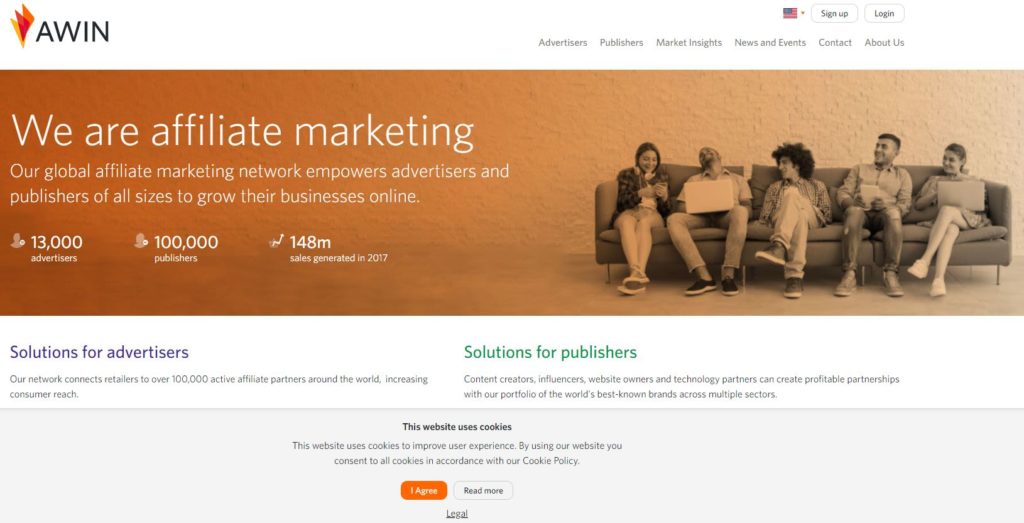What is affiliate marketing? A Practical Guide

Affiliate marketing is one of the types of digital marketing based on obtaining results. This means that the advertiser doesn’t pay for impressions or clicks but for the results obtained.
In this case, the websites, called affiliates, are responsible for advertising a given advertiser by publishing their ads or promotions. They can be products of companies (a hosting service to host a website) or bloggers (courses for social media management, for example).
These affiliates get a commission when the user enters the website and performs an action that has been previously determined, which can be clicking on a link, filling in a registration form or buying a product.
It’s beneficial for both advertisers and affiliates

One of the keys to this type of strategy is the community. If you’ve had a blog for some time now, chances are you already have an audience that follows you. If you’ve done your job well, with every published post you’ve earned their trust. That’s where one of the keys to affiliate marketing lies.
But that’s not enough: As with any other digital marketing technique, it’s very important to clearly define the goals you want to reach, the audience you’re going to target and the channel you’re going to use.
Affiliate marketing is beneficial both for the advertiser, who only pays if results are produced, and for affiliates, who must focus on directing traffic to the advertiser and collect the payment if actions and results are produced.
The Basic Foundations of Affiliate Marketing
There are a number of factors that powerfully influence the effectiveness of an affiliate marketing campaign. These are some of the most important ones:
1. Relevance
The main thing is that products or services that promotions really suit the interests of your readers. If you write about gadgets it doesn’t make much sense to promote Iberian blackleg ham.
And beware: If your blog becomes a meaningless bazaar, you run the risk of losing many readers.
2. Try it first
Before buying a product, what do you do? It’s common for you to search for the opinions of other users on forums or websites. If you’re going to promote a product, it’s best to try and test it yourself first, this in order to give a first-person opinion. No one will buy something just because you say so, unless you are persuasive.
If you intend to recommend a paid WordPress plugin, it’s best to try it out first, take some screenshots and post them on your post. That will give you more credibility and will allow you to build trust so your readers can be more receptive to your message.
3. Provide solutions
If you want your reader to buy the product or service you’re writing about, focus on promoting those that provide solutions. There are many people, for example, who are looking for plugins to publish their website in different languages. This is a problem for them and they are looking for a solution, so offer it to them.
4. A Versatile product
When promoting a product, try to make it easy to find information about it. Don’t focus on the fact that they are only interesting for your niche. Make your life easier when it comes to creating content, and opt for products about which there is a lot of information. This will also allow you to write different posts about the same product.
Another factor to take into account is that the product you are going to promote should be able to add accessories. This is a very interesting option because it will allow you to create different related blog entries.
5. A natural link
The era of big and eye-catching banners with claims about the features of a product is a thing of the past. After arousing curiosity and the desire to buy the product or service, the best way to guide readers to promotional content is a link in the text. It is one of the types of affiliate marketing that works the best, probably because of its simplicity and because it’s inserted in content that is valuable for the user.
6. Honesty
When writing about a product or service you must be honest and do not hide the fact that sales report a commission. But it’s also not about shouting it from the hills. If you are honest with the reader and they perceive that you are not just looking to ‘score a goal’, they will keep their trust on you even if they know that you are getting that commission.
Which products can be promoted through affiliate marketing?

Now that you have some clear concepts, it’s time to choose the product to promote. Which is the most appropriate? An easy way to know what kind of products arouse the most interest in people is to go to the most popular e-commerce.
In the case of Amazon, the giant of online commerce, you can see that it is as simple as clicking on “All Departments” and then on “Best-sellers”. Depending on the type of product you are interested in, you can navigate through the different categories.
The type of product you choose is critical to the success of an affiliate marketing campaign.
6 types of affiliate marketing
Affiliate marketing came into being in 1996 when Jeff Bezos, founder of Amazon, devised a way to link other marketers’ websites and for them to get a commission for every book sold on Amazon and referred through the other marketer’s website.
Six categories of affiliate marketing have been thus identified:
- Websites: It consists of websites focused on specific content that may interest advertisers of products related to those contents. The websites advertise the products and obtain a commission for each registration or sale achieved.
- Cashback and sites that share their earnings with users: In this case, there is a database of registered users with whom the commissions for the actions obtained are shared. Users make purchases through the affiliation platform and receive a percentage of return. There are three different types of this affiliation format:
- Directly distribution of money commissions.
- Those that assign points exchangeable for other products or services.
- Those who offer a discount or special promotion to perform the determined action.
- Affiliates working in search engines (Pay per click, PPC): In this case affiliates provide qualified traffic to merchants by buying words or phrases in search engines such as Google or Yahoo.
- E-mail marketing databases: Consists of the transfer of data from registered users who are interested in a matter related to the product offered by the merchant. The advertiser must know well the specific public and the type of customer so that the affiliate can make better use of its database. The most commonly used type of commission is the cost per thousand impressions (CPM).
- Co-registration databases: Users who are interested in the products or services of several companies can subscribe to the newsletter of an affiliate. The user expressly consents that their data may be sent to an advertiser in a particular sector in which the user is interested.
- Affiliation networks: Affiliation networks arise to regulate the relations between advertisers and affiliates. These networks act as intermediaries between thousands of advertisers and affiliates in addition to providing the tools for tracking sales directed from the page of an affiliate.
Advantages and disadvantages of affiliate marketing
Like any type of digital marketing, affiliate marketing has its benefits for both advertisers and media, but there are also disadvantages to it.
Advantages
The main advantage, from the point of view of online media, is that you don’t have to create a product or devise a service. Also, you don’t have to worry about offering customer service. All this will be the responsibility of the company which you derive the traffic to.
On the other hand, if you are a brand looking for affiliates, one of the main advantages is that the sales of your company can grow with economic investment thanks to external people. It’s not a fixed cost and, what is even more interesting, it can help you get brand ambassadors.
On the other hand, with affiliate marketing, it’s also possible to reach the audience you’re really interested in, which results in a higher return. This will be the case as long as you pay special attention to the media in which your brand will appear.
Disadvantages
From the point of view of the digital space, the first thing you have to bear in mind is that you should not abuse affiliate marketing. You have to pay attention to the number of times you use this marketing technique because the interest of your followers can vanish if they perceive that you only want to sell them products.
It’s also important to understand that you can’t relax: It’s necessary to put the same effort as if you were selling your own product, since your mission is to push your readers to buy the product you write about.
Another drawback is that the customers who fall into your networks are for your affiliates, so you cannot use remarketing to refer them to that or other products.
Main affiliate marketing networks in Spain
Currently, there are many affiliation platforms that you can access as a medium. These are some of the most interesting that you can find in the Spanish advertising market.
1. Awin

This platform was born from the merging of Zanox and Affiliate Window, and works to help both advertisers and affiliates looking to contact brands.
With 82 million sales generated in 2016, it currently has 100,000 active affiliates and 6,000 advertisers. Its clients include brands such as Bankia, Zalando, Yoigo and Meetic.
2. Trade Tracker

It is one of the networks that move more campaigns in Spain. It has a list of 250 advertisers, including many well-known brands such as 888Sport, Ali Express or Adeslas.
TradeTracker also has software for monitoring and real tracking of the results of the campaigns that have been launched. It also incorporates an online performance optimization service and campaigns activated by affiliates.
3.- Time One-Performance

The company, which integrates the firm Public-Ideas, offers solutions for affiliation, co-registration and online media campaigns. It is defined as a firm that covers the entire value chain of advertising affiliation, from strategic advice and decision support, to network animation and results measurement.
It has an international presence in 15 countries. It works on 1,200 online programs and exclusively administers more than 90% of the companies that work with them.
How sales are attributed
If you’re thinking about going into affiliate marketing, you may ask yourself another question: “How do they know you’ve derived a buyer?” At this point, technology comes into play. When a reader of your blog clicks on the ad your browser receives a tracking cookie. It stores, among other possible data, all the data of the advertiser as well as those of the medium of origin.
As you know, cookies enable browsers to store these data. In affiliate marketing, cookies are used to remember the link or ad that a website visitor has clicked on.
These files can also store the date and time of the click as well as other data regarding the user’s behavior. This kind of cookie is called a “first instance cookie”.
Do you need someone to help you in your performance marketing strategy? Find out here about how Antevenio can lend you a hand.

